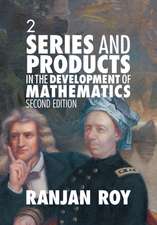The Proof is in the Pudding: The Changing Nature of Mathematical Proof
Autor Steven G. Krantzen Limba Engleză Hardback – 17 mai 2011
The first two chapters examine the early beginnings of concept of proof and the creation of its elegant structure and language, touching on some of the logic and philosophy behind these developments. The history then unfolds as the author explains the changing face of proofs. The more well-known proofs , the mathematicians behind them, and the world that surrounded them are all highlighted . Each story has its own unique past; there was often a philosophical, sociological, technological or competitive edge that restricted or promoted progress. But the author's commentary and insights create a seamless thread throughout the many vignettes.
Though there are many truths to be discovered in this book, by the end it is clear that there is no formalized approach or standard method of discovery to date. This is shown in noting some of the more prominent discussions currently underway, such as Gorenstein's effort to classify finance groups, Thomas Hale's resolution of the Kepler sphere-packing problem, and other modern tales. Most of the proofs are discussed in detail with figures and
some equations accompanying them, allowing both the professional mathematician and those less familiar with mathematics to derive the same joy from reading this book.
| Toate formatele și edițiile | Preț | Express |
|---|---|---|
| Paperback (1) | 296.58 lei 38-44 zile | |
| Springer – 23 aug 2016 | 296.58 lei 38-44 zile | |
| Hardback (1) | 293.87 lei 3-5 săpt. | |
| Springer – 17 mai 2011 | 293.87 lei 3-5 săpt. |
Preț: 293.87 lei
Nou
Puncte Express: 441
Preț estimativ în valută:
56.23€ • 58.86$ • 46.80£
56.23€ • 58.86$ • 46.80£
Carte disponibilă
Livrare economică 10-24 martie
Preluare comenzi: 021 569.72.76
Specificații
ISBN-13: 9780387489087
ISBN-10: 0387489088
Pagini: 264
Ilustrații: XVII, 264 p. 88 illus., 5 illus. in color.
Dimensiuni: 178 x 254 x 28 mm
Greutate: 0.74 kg
Ediția:2011
Editura: Springer
Colecția Springer
Locul publicării:New York, NY, United States
ISBN-10: 0387489088
Pagini: 264
Ilustrații: XVII, 264 p. 88 illus., 5 illus. in color.
Dimensiuni: 178 x 254 x 28 mm
Greutate: 0.74 kg
Ediția:2011
Editura: Springer
Colecția Springer
Locul publicării:New York, NY, United States
Public țintă
Professional/practitionerCuprins
1. What is a Proof and Why?.- 2. The Ancients.- 3. The Middle Ages and Calculation.- 4. The Dawn of the Modern Age.- 5. Hilbert and the Twentieth Century.- 6. The Four-Color Theorem.- 7. Computer-Generated Proofs.- 8. The Computer as a Mathematical Aid.- 9. Aspects of Mathematical Life.- 10. The Sociology of Mathematical Proof.- 11. A Legacy of Elusive Proofs.- 12. John Horgan and "The Death of Proof".- 13. Closing Thoughts.- Index of Names.- References.- Index.
Recenzii
“This book is to describe the essence, nature, and methodology of mathematical proof, with a strong emphasis on the change of these concepts in time. … It is written in a very clear and suggestive manner that makes the reading pleasant and rewarding … . Any reader will notice that the author has reached this goal in very convincing way, and the outcome is a brilliant work which should be found in every math library and department office.” (Jürgen Appell, zbMATH 1318.00005, 2015)
“In this book Steven Krantz undertakes the Miltonic task of justifying the ways of (pure) mathematicians to the world at large. … The concept of mathematical proof is at the heart of Krantz’s book. … mathematicians should find the book interesting, illuminating, provocative … .” (J. M. Plotkin, Mathematical Reviews, Issue 2012 b)
“The author traces the development of the idea of proof from Euclid through computer-aided and computer-generated proofs, pointing out the way some current social trends in mathematics affect the construction of nonstandard proofs. … This work provides good outside class reading for students--and not just mathematics majors; one could easily imagine this as a supplement to courses on the history or philosophy of science. Summing Up: Recommended. Lower-division
undergraduates through researchers/faculty; general readers.” (D. Robbins, Choice, Vol. 49 (2), October, 2011) “Krantz’s book is entertaining, can be read by the early undergraduate and puts forward some serious issues. There are few math books that are useful and valuable reading for all mathematicians, but this is one of them.” (Charles Ashbacher, The Mathematical Association of America, June, 2011)
“In this book Steven Krantz undertakes the Miltonic task of justifying the ways of (pure) mathematicians to the world at large. … The concept of mathematical proof is at the heart of Krantz’s book. … mathematicians should find the book interesting, illuminating, provocative … .” (J. M. Plotkin, Mathematical Reviews, Issue 2012 b)
“The author traces the development of the idea of proof from Euclid through computer-aided and computer-generated proofs, pointing out the way some current social trends in mathematics affect the construction of nonstandard proofs. … This work provides good outside class reading for students--and not just mathematics majors; one could easily imagine this as a supplement to courses on the history or philosophy of science. Summing Up: Recommended. Lower-division
undergraduates through researchers/faculty; general readers.” (D. Robbins, Choice, Vol. 49 (2), October, 2011) “Krantz’s book is entertaining, can be read by the early undergraduate and puts forward some serious issues. There are few math books that are useful and valuable reading for all mathematicians, but this is one of them.” (Charles Ashbacher, The Mathematical Association of America, June, 2011)
Notă biografică
Steven Krantz is a well-known Springer author. He has written nine books with Springer (1-931914-59-1, 0-8176-4339-7, 0-8176-4011-8, 0-8176-4339-7, 0-8176-4220-X, 0-8176-4097-5, 1-930190-87-5, 0-8176-4264-1, 0-8176-4285-4 ) with sales accumulating almost $130,000 in North America. Prof. Krantz is the editor-in-chief of the "society" journal (published in cooperation with Springer) "The Journal of Geometric Analysis" and is also the present editor-in-chief of the AMS Notices. "The Proof is in the Pudding, is the first of its kind. It details the history of the proof from its beginnings to its place in present-day mathematics. (This was presented as a "hot topic" in an article in the Notices of the AMS.)
Textul de pe ultima copertă
Krantz’s book covers the full history and evolution of the proof concept. The notion of rigorous thinking has evolved over time, and this book documents that development. It gives examples both of decisive developments in the technique of proof and also of magnificent blunders that taught us about how to think rigorously. Many historical vignettes illustrate the concepts and acquaint the reader with how mathematicians think and what they care about.
In modern times, strict rules for generating and recording proof have been established. At the same time, many new vectors and forces have had an influence over the way mathematics is practiced. Certainly the computer plays a fundamental role in many mathematical investigations.
But there are also fascinating social forces that have affected the way that we now conceive of proof. Daniel Gorenstein’s program to classify the finite simple groups, Thomas Hales’s resolution of the Kepler sphere-packing problem, Louis de Branges’s proof of the Bieberbach conjecture, and Thurston’s treatment of the geometrization program are but some examples of mathematical proofs that were generated in ways inconceivable 100 years ago. Krantz treats all of them---and more---in some detail; he names the players and tells all the secrets.
Many of the proofs treated in this book are described in some detail, with figures and explanatory equations. The reader is given a dose of modern mathematics, and h
ow mathematicians think. Both the joy and the sorrow of mathematical exploration are communicated dynamically and energetically in this exciting new book.
In modern times, strict rules for generating and recording proof have been established. At the same time, many new vectors and forces have had an influence over the way mathematics is practiced. Certainly the computer plays a fundamental role in many mathematical investigations.
But there are also fascinating social forces that have affected the way that we now conceive of proof. Daniel Gorenstein’s program to classify the finite simple groups, Thomas Hales’s resolution of the Kepler sphere-packing problem, Louis de Branges’s proof of the Bieberbach conjecture, and Thurston’s treatment of the geometrization program are but some examples of mathematical proofs that were generated in ways inconceivable 100 years ago. Krantz treats all of them---and more---in some detail; he names the players and tells all the secrets.
Many of the proofs treated in this book are described in some detail, with figures and explanatory equations. The reader is given a dose of modern mathematics, and h
ow mathematicians think. Both the joy and the sorrow of mathematical exploration are communicated dynamically and energetically in this exciting new book.
Caracteristici
An extensive evolution of the proof presented for the first time in book form. Topics cover centuries of mathematical history, dating back to Eudoxus and Euclid and span the ages to conclude with the some versatile, present-day use of the proof. Author expresses keen insights and a wealth of historical knowledge. Proofs are presented and accompanied by figures, equations and examples. Includes supplementary material: sn.pub/extras



















